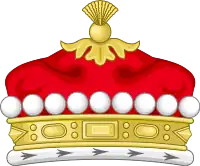Paul Pellew, 10th Viscount Exmouth
Paul Edward Pellew, 10th Viscount Exmouth, 9th Marquess of Olías (born 8 October 1940),[1] is a British peer.[2] He succeeded his father, Pownoll Pellew, 9th Viscount Exmouth (1908–1970), on the latter's death.
Despite succeeding to the peerage in 1970, he did not make his maiden speech in the House of Lords until 20 December 1995. He opened his speech, which was on the subject of chequebook journalism, with a statement that his main interests lay with the tourist industry.[3]
In 1975, he married Rosemary Frances Scoones Beauclerk, a daughter of Francis Harold Scoones of West Ham and his wife Rose Frances E. Callis, and the ex-wife of Murray Beauclerk, 14th Duke of St. Albans.
In 1999, he was recognized by the Spanish government as the Marquess of Olías, a title in the Spanish nobility that dates from 1652 and was previously held by his mother, María Luisa de Urquijo y Losada.[4]
Arms
  |
|
References
- HANSARD 1803–2005 - People - Mr Paul Pellew
- Vacher's Parliamentary Companion, No. 1092, December 1998, p. 137.
- Cheque-book Journalism (Hansard, 20 December 1995)
- Antonio Luque García (2005). Grandezas de España y títulos nobiliarios (in Spanish). Ministerio de Justicia. p. 258. ISBN 978-84-7787-825-4. Retrieved 9 April 2017.
- Burke's Peerage. 1838.